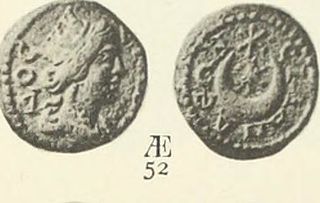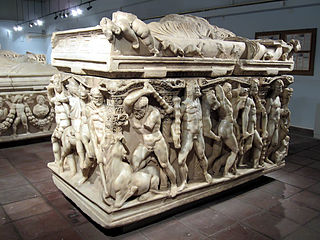Related Research Articles
Acmonia or Akmonia is an ancient city of Phrygia Pacatiana, in Asia Minor, now known as Ahat Köyü. It is mentioned by Cicero and was a point on the road between Dorylaeum and Philadelphia. Under the Romans, it was within the conventus iuridicus of Apamea.
Mossyna or Mosyna (Μοσύνα) was a city of the middle Maeander valley in the late Roman province Phrygia Pacatiana II. It is mentioned as a bishopric by Hierocles and other ecclesiastical writers. It may have been named for the classical Mossynoeci, or for the Greek word for a wooden tower (Μοσσύν).

Tripolis on the Meander – also Neapolis, Apollonia, and Antoniopolis – was an ancient city on the borders of Phrygia, Caria and Lydia, on the northern bank of the upper course of the Maeander, and on the road leading from Sardes by Philadelphia to Laodicea ad Lycum. It was situated 20 km to the northwest of Hierapolis.
Savatra, Sabatra, or Soatra was a city in the Roman province of Galatia, and subsequently the Byzantine province of Lycaonia.
Motella, Metello(u)polis, or Pulcherianopolis was a city in the Roman province of Phrygia Pacatiana, in Asia Minor, probably on the site of the modern Medele.

Silandus or Silandos was an episcopal city in the late Roman province of Lydia. It was near and gave its name to the present town of Selendi in Manisa Province, Turkey.

Tiberiopolis was a town in the Roman province of Phrygia Pacatiana, mentioned by Ptolemy, Socrates of Constantinople and Hierocles. At various times, it was considered as part of Phrygia, Isauria, and the late Roman province of Pisidia.
Temnos or Temnus was a small Greek polis (city-state) of ancient Aeolis, later incorporated in the Roman province of Asia, on the western coast of Anatolia. Its bishopric was a suffragan of Ephesus, the capital and metropolitan see of the province, and is included in the Catholic Church's list of titular sees.
Doara was a town of ancient Cappadocia, inhabited in Byzantine times. It was in the Chamanene prefecture created by Archelaus of Cappadocia during Hellenistic times. The town appears on the Peutinger Table between Caesarea and Tavium. It was also mentioned by Hierocles as Rhegedoara (Ῥεγεδοάρα), and the Notitiae Episcopatuum.

Sacred Heart Roman Catholic Church is a Roman Catholic Church in Ozora in Ste. Genevieve County, Missouri.
Isba was a city on the border of ancient Pamphylia. It has been identified with the modern village of Çeşme.
Daldis, was a town on the borders of ancient Lydia and Phrygia, a former bishopric, and is now a Latin Catholic titular see. It also minted coins in antiquity with the legend Δαλδιανων. It also bore the name Flaviocaesaria or Phlabiokaisareia, which is not attested among ancient authors but is reconstructed from epigraphic and other evidence.
Apollonos Hieron was an ancient city of Lydia.

Tabala, is the name of a Roman and Byzantine town and a Bishopric in ancient Lydia. Tabala was on the Hermus River, and minted its own coins. It is no doubt the same as the one mentioned by Hierocles under the name of Gabala, which is perhaps only miswritten for Tabala. It is even possible that it may be the town of Tabae or Tabai (Τάβαι), which Stephanus of Byzantium assigns to Lydia.

Isaura Nea, in Latin Isaura Nova, both meaning 'New Isaura', was a town of the Roman and Byzantine era, so called in juxtaposition with the settlement of Isaura Palaea. It also bore the name Leontopolis, and in later days was included in the province of Lycaonia.
Maionia or Maeonia, was a city of the Hellenistic, Roman and Byzantine era located near the Hermos River, in ancient Lydia. Both Ramsay and Talbert tentatively identified the ancient polis with the modern village of Koula a village known for its carpet manufacture.

Cinna or Kinna was a town of ancient Galatia. It was also the seat of a bishop; no longer a residential see, it remains a titular see of the Roman Catholic Church.
Homana, also known as Homona and Homonanda, was a town of ancient Pisidia and later of Isauria and Lycaonia, inhabited in Hellenistic and Roman times. Pliny the Elder puts the town in Pisidia. It appears in the Synecdemus as part of Lycaonia under the name Umanada or Oumanada. It was the capital of the Homanadeis (Ὁμαναδεῖς), who, besides Homana, are said by Tacitus to have possessed 44 forts, a statement opposed to the remarks of Strabo, according to which the Homanades, the most barbarous of all Pisidian tribes, dwelt on the northern slope of the highest mountains without any towns or villages, living only in caves. In the reign of Augustus, the consul Quirinius compelled this little tribe, by famine, to surrender, and distributed 4000 of them as colonists among the neighbouring towns. It became a bishopric; no longer the seat of a residential bishop, it remains, under the name of Homona, a titular see of the Catholic Church.
Aurokra or Aurokla or Aurocla or Aulokra was a town of ancient Phrygia, inhabited during Roman and Byzantine times. It became a bishopric; no longer a residential bishopric, it remains, under the name Aurocla, a titular see of the Roman Catholic Church.
Dioclea or Dioklea, Dioclia or Dioklia, Diocleia or Diokleia, was a town of ancient Phrygia, inhabited during Roman and Byzantine times.
References
- ↑ Jones, Arnold Hugh Martin (1971). The Cities of the Eastern Roman Provinces (2 ed.). Oxford University Press. p. 137. ISBN 9780198142812. LCCN 74025037. OCLC 185408033.
- ↑ Catholic Hierarchy
- ↑ Ramsay, William Mitchell (1890). "Lykaonia and Tyanitis". The Historical Geography of Asia Minor. London: John Murray. pp. 344–345. LCCN unk82041708.